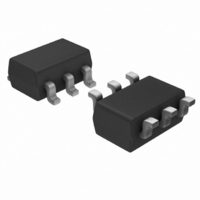LT1395CS6#TR Linear Technology, LT1395CS6#TR Datasheet - Page 10

LT1395CS6#TR
Manufacturer Part Number
LT1395CS6#TR
Description
IC AMP CURR FEEDBACK SGL SOT23-6
Manufacturer
Linear Technology
Datasheet
1.LT1396CDD.pdf
(20 pages)
Specifications of LT1395CS6#TR
Amplifier Type
Current Feedback
Number Of Circuits
1
Slew Rate
800 V/µs
-3db Bandwidth
400MHz
Current - Input Bias
10µA
Voltage - Input Offset
1000µV
Current - Supply
4.6mA
Current - Output / Channel
80mA
Voltage - Supply, Single/dual (±)
4 V ~ 12 V, ±2 V ~ 6 V
Operating Temperature
0°C ~ 70°C
Mounting Type
Surface Mount
Package / Case
SOT-23-6
Lead Free Status / RoHS Status
Contains lead / RoHS non-compliant
Output Type
-
Gain Bandwidth Product
-
Available stocks
Company
Part Number
Manufacturer
Quantity
Price
APPLICATIONS INFORMATION
LT1395/LT1396/LT1397
Feedback Resistor Selection
The small-signal bandwidth of the LT1395/LT1396/LT1397
is set by the external feedback resistors and the inter-
nal junction capacitors. As a result, the bandwidth is a
function of the supply voltage, the value of the feedback
resistor, the closed-loop gain and the load resistor. The
LT1395/LT1396/LT1397 have been optimized for ± 5V
supply operation and have a –3dB bandwidth of 400MHz
at a gain of 1 and 350MHz at a gain of 2. Please refer to
the resistor selection guide in the Typical AC Perfor-
mance table.
Capacitance on the Inverting Input
Current feedback amplifi ers require resistive feedback from
the output to the inverting input for stable operation. Take
care to minimize the stray capacitance between the output
and the inverting input. Capacitance on the inverting input
to ground will cause peaking in the frequency response
(and overshoot in the transient response).
Capacitive Loads
The LT1395/LT1396/LT1397 can drive many capacitive
loads directly when the proper value of feedback resistor
is used. The required value for the feedback resistor will
increase as load capacitance increases and as closed-
loop gain decreases. Alternatively, a small resistor (5Ω
to 35Ω) can be put in series with the output to isolate the
capacitive load from the amplifi er output. This has the
advantage that the amplifi er bandwidth is only reduced
when the capacitive load is present. The disadvantage is
that the gain is a function of the load resistance. See the
Typical Performance Characteristics curves.
Power Supplies
The LT1395/LT1396/LT1397 will operate from single or split
supplies from ± 2V (4V total) to ±6V (12V total). It is not
necessary to use equal value split supplies, however the
offset voltage and inverting input bias current will change.
The offset voltage changes about 2.5mV per volt of supply
mismatch. The inverting bias current will typically change
about 10μA per volt of supply mismatch.
10
Slew Rate
Unlike a traditional voltage feedback op amp, the slew rate
of a current feedback amplifi er is not independent of the
amplifi er gain confi guration. In a current feedback ampli-
fi er, both the input stage and the output stage have slew
rate limitations. In the inverting mode, and for gains of 2
or more in the noninverting mode, the signal amplitude
between the input pins is small and the overall slew rate
is that of the output stage. For gains less than 2 in the
noninverting mode, the overall slew rate is limited by the
input stage.
The input slew rate of the LT1395/LT1396/LT1397 is ap-
proximately 600V/μs and is set by internal currents and
capacitances. The output slew rate is set by the value of
the feedback resistor and internal capacitance. At a gain
of 2 with 255Ω feedback and gain resistors and ± 5V
supplies, the output slew rate is typically 800V/μs. Larger
feedback resistors will reduce the slew rate as will lower
supply voltages.
Enable/Disable
The LT1395CS6 has a unique high impedance, zero sup-
ply current mode which is controlled by the EN pin. The
LT1395CS6 is designed to operate with CMOS logic; it
draws virtually zero current when the EN pin is high. To
activate the amplifi er, its EN pin is normally pulled to a
logic low. However, supply current will vary as the volt-
age between the V
in Figure 1, +I
when the voltage difference is less than 3V. For normal
5.0
4.5
4.0
3.5
3.0
2.5
2.0
1.5
1.0
0.5
0
S
0
T
V
does vary with (V
Figure 1. + I
A
+
= 25°C
= 5V
1
+
supply and EN is varied. As seen
2
V
–
V
= –5V
+
S
3
– V
vs (V
EN
4
(V)
+
V
– V
–
+
= 0V
5
– V
EN
)
1395/6/7 F01
6
EN
), particularly
7
139567fd













